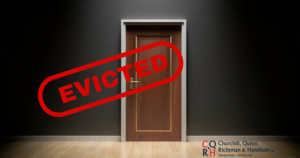Eviction Procedures That Landlords and Tenants Should Know
 A landlord’s perfect scenario is renting to someone who is quiet, respectful of their property and pays the rent on time every month. Likewise, a renter expects a safe, well-maintained property in exchange for rents paid. But when a landlord feels that the tenant does not abide by the rules set forth in their rental agreement, there is a specific eviction process that must be followed in order to remove them from the property.
A landlord’s perfect scenario is renting to someone who is quiet, respectful of their property and pays the rent on time every month. Likewise, a renter expects a safe, well-maintained property in exchange for rents paid. But when a landlord feels that the tenant does not abide by the rules set forth in their rental agreement, there is a specific eviction process that must be followed in order to remove them from the property.
Give Notice
This is the renter’s home and they cannot be told to move without warning. A landlord must give written notice to the renter and allow them the opportunity to respond to the claims. The three basic types of eviction notices are:
- Pay Rent or Quit – gives the tenant a few days to pay past-due rent or “quit” the lease
- Cure or Quit – allows the tenant to fix the problem (such as a pet or other violation) or quit the lease
- Unconditional Quit – requires the tenant to leave the premises or quit the lease without any opportunity to correct a problem or get current on rent
Tenant Might Not Leave
Even if served an eviction notice, a tenant may feel that the landlord is the one at fault, and therefore they have a right to remain in the property. The tenant’s defense could include factors such as the landlord not providing proper notice, poor maintenance of the rental property, retaliation for the tenant reporting code violations or discrimination in violation of the Fair Housing Act.
Legal Intervention
When a tenant refuses to abide by the terms of an eviction notice, legal action is required to resolve the dispute and ensure that the terms of the lease are being followed. Churchill, Quinn, Richtman & Hamilton can represent both landlords and tenants throughout the legal proceedings, from preparing and filing the proper documents through litigation, if necessary. Contact us at 847-223-1500 to speak to one of our knowledgeable attorneys or visit dev-cqrh.pantheonsite.io for more information.
Full referenced article HERE
